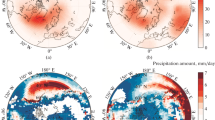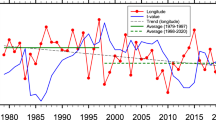Abstract
The temperature, surface pressure, and cloud cover for Siberia (50°–70° N; 60°–110° E) in the winter period (December–February) are estimated over 1976–2011 based on data from 163 meteorological stations. Using surface synoptic maps, time series of winter cyclone characteristics, such as the total number and central pressure, are derived for the same period. Two time intervals are found in variations of climatic characteristics and cyclone activity characteristics: 1976–1990 and 1991–2011. In the first period, the temperature and cloud cover increased and the surface pressure fell, which reduced the number of cyclones and intensified (deepened) them. In the second period, opposite trends took place. The correlation analysis between the climate variables and cyclonic activity characteristics allowed us to consistently describe the impact of cyclones on the surface pressure and cloudiness.
Similar content being viewed by others
References
J. H. Yin, “A consistent poleward shift of the storm tracks in simulations of 21st century climate,” Geophys. Res. Lett. 32, L18701 (2005). doi 10.1029/2005GL023684
S. J. Lambert and J. C. Fyfe, “Changes in winter cyclone frequencies and strengths simulated in enhanced greenhouse warming experiments: Results for the models participating in the IPCC diagnostic exercise,” Clim. Dynam. 26, 713–728 (2006). doi 10.1007/s00382-006-0110-3
E. K. M. Chang, Y. Guo, and X. Xio, “CMIP5 multimodel ensemble projection of storm track change under global warming,” J. Geophys. Res. 117, D23118 (2012). doi 10.1029/2012JD18578
B. J. Harvey, L. C. Shaffrey, and T. J. Woollings, “Equator-to-pole temperature differences and the extra-tropical storm track responses of the CMIP5 climate models,” Clim. Dyn. 43, 1171–1182 (2014). doi 10.1007/s00382-013-1883-9
U. Ulbrich, G. C. Leckebusch, and J. G. Pinto, “Extratropical cyclones in the present and future climate: A review,” Teor. Appl. Climatol. 96 (1–2), 117–131 (2009).
S. K. Gulev, O. Zolina, and S. Grigoriev, “Extratropical cyclone variability in the Northern Hemisphere winter from NCEP/NCAR reanalysis data,” Clim. Dyn. 17 (10), 795–809 (2001).
X. Wang, V. Swail, and F. Zwiers, “Climatology and changes of extratropical cyclone activity: comparison of ERA40 with NCEP/NCAR reanalysis for 1958–2001,” J. Climate 19 (13), 3145–3166 (2006).
F. Feser, M. Barcikowska, O. Krueger, F. Schenk, R. Weisse, and L. Xia, “Storminess over the North Atlantic and Northwestern Europe—a review,” Q.J.R. Meteorol. Soc. 141 (687), 350–382 (2015).
B. J. Harvey, L. C. Shaffrey, T. J. Woollings, G. Zappa, and K. I. Hodges, “How large are projected 21st century storm track changes?,” Geophys. Res. Lett. 39, L18707 (2012). doi 10.1029/2012GL052873
G. Zappa, L. C. Shaffrey, K. I. Hodges, P. G. Sansom, and D. B. Stephenson, “A multimodel assessment of future projections of North Atlantic and European extratropical cyclones in the CMIP5 climate models,” J. Climate 26 (16), 5846–5862 (2013).
K. I. Hodhes, R. W. Lee, and L. Bengtsson, “A comparison of extratropical cyclones on recent reanalysis ERA-Interim, NASA MERRA, NCEP CFSR and JRA-25,” J. Climate 24 (18), 4888–4906 (2011).
U. Neu, M. G. Akperov, N. Bellenbaum, R. Benestad, R. Blender, R. Caballero, A. Cocozza, H. F. Dacre, Y. Feng, K. Fraedrich, J. Grieger, S. Gulev, J. Hanley, T. Hewson, M. Inatsu, K. Keay, S. F. Kew, I. Kindem, G. S. Leckebusch, M. L. R. Liberato, P. Lionello, I. I. Mokhov, J. G. Pinto, C. C. Raible, M. Reale, I. Rudeva, M. Schuster, I. Simmonds, M. Sinclair, M. Sprenger, N. D. Tilinina, I. F. Trigo, S. Ulbrich, U. Ulbrich, X. L. Wang, and H. Wernli, “IMILAST: A community efforts to intercompare extratropical cyclone detection and tracking algorithms,” Bull. Amer. Meteorol. Soc. 94, 529–547 (2013).
G. A. Meehl, J. M. Ablaster, J. T. Fasullo, A. Hu, and K. E. Trenberth, “Model-based evidence of deepocean heat uptake during surface-temperature hiatus periods,” Nat. Clim. Change 1, 360–364 (2011).
Y. Kosaka and S. P. Xie, “Recent global-warming hiatus tied to equatorial Pacific surface cooling,” Nature 501 (7467), 403–407 (2003).
C. Li, B. Stevens, and J. Marotzke, “Eurasian winter cooling in the warming hiatus of 1998–2012,” Geophys. Res. Lett. 42, 8131–8139 (2015). doi 10.1002/2015GL065327
J. L. Johen, J. C. Furtado, M. Barlow, V. A. Alexeev, and J. E. Cherry, “Asymmetric seasonal temperature trends,” Geophys. Res. Lett. 39, L04705 (2012). doi 10.1029/2011GL050582
S. Outten, R. Davy, and I. Esay, “Eurasian winter cooling: Intercomparison of reanalysis and CMIP5 data sets,” Atmos. Oceanic Sci. Lett. 6 (5), 324–331 (2013).
M. V. Kabanov, “Western Siberian regional climateforming factors,” Geogr. Prirod. Resursy, 3, 107–113 (2015).
P. J. Mailier, D. B. Stephenson, C. A. T. Ferro, and K. I. Hodges, “Serial clustering of extratropical cyclones,” Mon. Weather. Rev. 134 (8), 2224–2240 (2006).
X. Zhang, J. E. Walsh, J. Zhang, U. S. Bhatt, and M. Ikeda, “Climatology and interannual variability of Arctic cyclone activity: 1948–2002,” J. Climate 17 (12), 2300–2317 (2004).
I. I. Ippolitov, M. V. Kabanov, S. V. Loginov, and E. V. Kharyutkina, “Structure and dynamic of meteorological fields on the Asian region of Russia in the period of the global warming for 1975–2005,” Zh. Sibir. Federal. Univ., Biol. 1 (4), 323–344 (2008).
E. T. Chemekova, M. A. Boltovskaya, S. V. Loginov, M. V. Pakhmesterova, and N. S. Terskova, “Variability of vortex activity in the Asian Russia in late 20th–early 21st centuries,” in Abstracts of the 10th Siberian Workshop on the Climate and Ecological Monitoring, Ed. by M. V. Kabanov (Agraf-Press, Tomsk, 2013), p. 157 [in Russian].
V. P. Gorbatenko, I. I. Ippolitov, and N. V. Podnebesnykh, “Atmospheric circulation over Western Siberia in 1976–2004,” Rus. Meteorol. Hydrol. 32 (5), 301–306 (2007).
S. D. Outten and I. Esau, “A link between Arctic sea ice and recent cooling trends over Eurasia,” Clim. Change 110, 1069–1075 (2012).
J. E. Overland and M. Wang, “Large-scale atmospheric circulation changes are associated with the recent loss of Arctic sea ice,” Tellus, A 62 (1), 1–9 (2010).
V. Petoukhov and V. A. Semenov, “A link between reduced Barents–Kara Sea ice and cold winter extremes over northern continents,” J. Geophys. Res. 115, D21111 (2010).
D. W. Kim, H. R. Byun, and Y. I. Lee, “The long-term changes of Siberian High and winter climate over the Northern hemisphere,” J. Korean. Meteorol. Soc. 41 (2–1), 275–283 (2005).
D. Y. Gong and C. H. Ho, “The Siberian High and climate change over middle to high latitude Asia,” Theor. Appl. Climatol. 72 (1–2), 1–9 (2002).
H. M. Hasanean, M. Almazroui, P. D. Jones, and A. A. Alemoudi, “Siberian High variability and its teleconnections with tropical circulation and surface air temperature over Saudi Arabia,” Clim. Dyn. 41 (7–8), 2003–2018 (2013).
A. Chernokulsky, I. I. Mokhov, and N. Nikitina, “Winter cloudiness variability over Northern Eurasia related to the Siberian High during 1966–2010,” Environ. Res. Lett. 8 (2013). 045012
I. I. Mokhov, A. V. Chernokul’skii, M. G. Akperov, J.-L. Dufresne, and H. Le Treut, “Variations in the characteristics of cyclonic activity and cloudiness in the atmosphere of extratropical latitudes of the Northern Hemisphere based from model calculations compared with the data of the reanalysis and satellite data,” Dokl., Earth Sci. 424 (1), 147–150 (2009).
E. I. Khlebnikova and I. A. Sall, “Peculiarities of climatic changes in cloud cover over the Russian Federation,” Rus. Meteorol. Hydrol. 34 (7), 411–417 (2009).
V. S. Komarov, G. G. Matvienko, S. N. Il’in, and N. Ya. Lomakina, “Estimate of local features of longterm variations in cloud cover over the territory of Siberia using results of its climatic zoning according to total and low-level cloud regimes,” Atmos. Ocean. Opt. 28 (3), 265–272 (2015).
X. Zhang, C. Lu, and Z. Guan, “Weakened cyclones, intensified anticyclones and recent extreme cold winter weather events in Eurasia,” Environ. Res. Lett. 7 (4), 044044 (2012).
J.-H. Jeong, T. Ou, H. W. Linderholm, B.-M. Kim, J.-S. Kug, and D. Chen, “Recent recovery of the Siberian High intensity,” J. Geophys. Res. 116, D23102 (2011). doi 10.1029/2011JD015904
N. P. Shakina, Dynamics of Atmospheric Fronts and Cyclones (Gidrometeoizdat, Leningrad, 1985) [in Russian].
Author information
Authors and Affiliations
Corresponding author
Additional information
Original Russian Text © N.V. Podnebesnykh, I.I. Ippolitov, M.V. Kabanov, 2017, published in Optika Atmosfery i Okeana.
Rights and permissions
About this article
Cite this article
Podnebesnykh, N.V., Ippolitov, I.I. & Kabanov, M.V. Connections between climatic characteristics and cyclonic activity in winter over Siberia in 1976–2011. Atmos Ocean Opt 30, 55–62 (2017). https://doi.org/10.1134/S1024856017010109
Received:
Published:
Issue Date:
DOI: https://doi.org/10.1134/S1024856017010109




